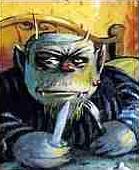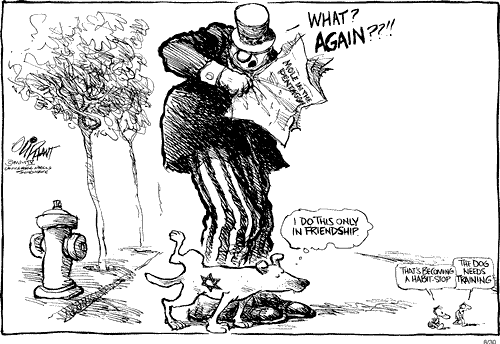
Politico Punch-Card Cartoon Absurdly Suggests Israel Gets a “Free Pass”
The cartoon doesn’t go as far as Holocaust inversion, but it is related to that phenomenon in that it uses the Holocaust “as a stick to beat” Israel.



 German newspaper Sí¼ddeutsche Zeitung published a cartoon depicting Israel as the child-eating pagan deity Moloch, recalling both the age-old blood libel against Jews and Holocaust-era anti-Semitic cartoons.
German newspaper Sí¼ddeutsche Zeitung published a cartoon depicting Israel as the child-eating pagan deity Moloch, recalling both the age-old blood libel against Jews and Holocaust-era anti-Semitic cartoons.  In his syndicated drawings which habitually depict Israel negatively, facts are not part of the picture.
In his syndicated drawings which habitually depict Israel negatively, facts are not part of the picture.
 A Los Angeles Times op-ed by Stephen Walt and John Mearsheimer spewed more of the authors anti-Israel inaccuracies and was accompanied by an anti-Semitic cartoon more at home in a neo-Nazi publication than a supposedly major newspaper.
A Los Angeles Times op-ed by Stephen Walt and John Mearsheimer spewed more of the authors anti-Israel inaccuracies and was accompanied by an anti-Semitic cartoon more at home in a neo-Nazi publication than a supposedly major newspaper. The political cartoonist Pat Oliphant's cartoons rely on classic images: Democrat as donkey; Republican as elephant. Recently, however, he evoked a more distrurbing image—one more commonly associated with Nazi propaganda or anti-Semitic rants of extremist Islamist clerics, in his portrayal of Jews as dogs.

The February 13, 2004 edition of USA Today published as an advertisement a large editorial cartoon depicting Israeli Prime Minister Ariel Sharon controlling the US media, a cartoon closely mirroring anti-Israeli, anti-American illustrations common in the Middle Eastern press and even neo-Nazi publications. CAMERA contacted the newspaper and was promised that future ads will be more closely scrutinized and vetted.